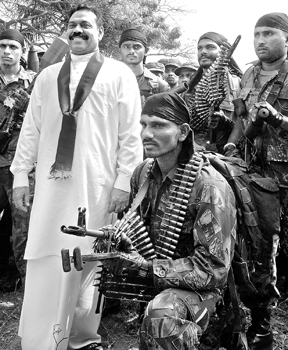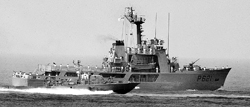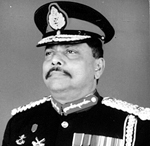
|
After Sampur and Vakarai, LTTE threats loom
It was the fall of Sampur in September last year that made the "Four Six" sector south of Trincomalee more important to the Liberation Tigers of Tamil Eelam (LTTE). Until then, Sampur, located strategically south of the Trincomalee Harbour was the main staging area. From there, the guerrillas directed artillery and mortar attacks at Sri Lanka Navy's largest base inside the Dockyard in Trincomalee. Even the Sri Lanka Air Force base located across the harbour at China Bay became vulnerable. The re-capture put paid to that. The guerrillas moved lock, stock and barrel to other locations further south of Sampur. A greater concentration moved to an otherwise sleepy coastal fishing village of Vakarai. North of that area lay a number of other guerrilla encampments. That included a mortar base near Kanthaladi, a political office further north, a Sea Tiger base at Palchenai and a large guerrilla base including a training facility at Kathiraveli. South of the location, the guerrillas had established a major road block on one end of the bridge at Panichchankerni. Much beyond the other end lay the Army Camp at Kajuwatte.
In the post-Sampur scenario after September 4, Vakarai and its environs thus became a greater threat factor. There was a contiguous land mass the guerrillas were now concentrating on. They were developing the capability to receive unimpeded logistical support and enjoy greater freedom of movement. A consolidation of these factors would have seen the emergence of a new and strong military infrastructure for the guerrillas in the East. Within days of the Sampur re-capture, military planners went to work. Just eight weeks later the Army began its top secret operation to evict the LTTE from Vakarai and adjoining areas. One of the hallmarks of it was to ensure troops suffered minimum casualties whilst they inflicted heavy damage on the enemy. At the forefront were small groups of Special Forces who stealthily moved behind enemy lines to wreak havoc. Infantry troops in small groups chipped in every now and then to take on some guerrilla camps. Air Force Kfir jets carried out several bombing raids on guerrilla camps. Six weeks later, by mid January, the first phase of the operation had been concluded. It led to two distinct advantages - One to keep the guerrillas shift location with their equipment from place to place for fear of attacks. In the process, they were forced to bury some of their heavy weapons. Secondly, such a move led to Army positions becoming less vulnerable. Among the locations where guerrilla camps or groups were attacked, according to senior officers at the Army's 223 Brigade Headquarters, were Kattamurvikulam, Echalampattu, Mavil Aru, Karuwapoochenai and Kajuwatte north. All these were among the areas that constituted the "Four Six" sector of the LTTE in the East. Seizing on the disarray of the guerrillas, the Army launched the second phase of its offensive on January 16. It was two pronged - a column of commandos marching down from Echalampattu in the direction of Kathiraveli towards Vakarai. Another advanced northwards from Panichchankerni. The latter was after Special Forces groups infiltrated the guerrilla-held area to advance northwards from the beachfront. Like the first phase of the operation, plans were to move slowly to avoid casualties to own troops. A senior Army officer involved in the operation said the pincer movement caught the guerrillas, who had dug in to fight for a longer period, to panic. Instead of facing a full frontal assault from two different sides, they decided to make a hurried withdrawal. Orders from guerrilla military leaders in Kilinochchi to back out if there was heavy pressure from the Army had reached the guerrilla leader directing the offensive, "Colonel" Sornam. He was operating from a guerrilla base east of Mavil Aru, in the general area of Echalampattu.
Vakarai, from where the guerrillas made a hasty retreat, fell into Army hands just three days (on January 19) after the second phase was launched. But it took another three days for troops to consolidate the gains and enhance security around the area. Now that the operation has ended, some of the casualty counts can be revealed. Senior Army officials claim that more than 748 guerrillas were killed and 316 were wounded. However, this claim cannot be independently verified. If they are indeed correct, the most import question that could help discern ground realties better would be what percentage of the LTTE strength in the east did these dead guerrillas constitute. The dead and wounded add up to 1064. Particularly in the wake of their hurried withdrawal instead of confronting the troops, a question of great interest would be how many more guerrillas are now left in the area. If it is only a handful they would not pose a threat at all. That would certainly be good news. But if they are a larger number, it does not take anyone, except the dim witted, to say the guerrillas who withdrew will be back to fight another day. It was only on Wednesday Tiger guerrillas exploded a claymore mine in Vantharamoolai in Batticaloa town area killing 11 persons on the spot and wounding 19 others. Six of those killed were police officers whilst four were Army soldiers and one was a civilian. A police officer died in hospital bringing the toll to 12. Seven of the injured were Army soldiers. Among the injured were eight police officers and three civilians. The fact that such an incident took place in the Government-controlled town area was clear proof of not only LTTE presence but also of its plans to continue to carry out attacks. Three officers and 27 Special Forces troops, the officials said, were killed and a further seven officers and 148 soldiers were wounded. They also said that six commandos were killed and 19 others were wounded. At least for the time being, that has ended the military aspects of the re-capture of Vakarai. Now comes the more expensive task for the Government of re-settling the more than 35,000 internally displaced persons in Vakarai and the immediate neighbourhood. But the formal announcement by senior Army officers of impending operations in other areas has led to a further exodus of IDPs. This is particularly high in Toppigala, one of the areas the Army wants to clear. As reported last week, state intelligence agencies say more than 300 guerrillas had fled to the jungles of Toppigala after the re-capture of Vakarai. It is in this backdrop that President Mahinda Rajapaksa paid a surprise visit to Vakarai and Sampur yesterday in the company of military top brass. He addressed troops in both locations. He praised them for the role in re-capturing the two strategic locations and declared the Government greatly appreciated their efforts. The visit came just a day before Sri Lanka commemorates the 59th anniversary of independence today. The ongoing military activity comes with only 17 days to go for the fifth anniversary of the Ceasefire Agreement (CFA). Its provisions now remain only on paper as an undeclared Eelam War IV continues to escalate. Media reports that the Government has sent a fresh appeal through Norway to the LTTE to resume peace talks were dismissed in diplomatic circles yesterday as false. Norway's Ambassador Hans Brattskar told The Sunday Times he had carried no such proposal from the Government. His visit to Kilinochchi for a meeting with the leader of the LTTE Political Wing, S.P. Thamilselvan, was part of a regular routine. He had planned another visit next month. Other sources said during a lengthy discussion with Mr. Brattskar, Mr. Thamilselvan had raised issues relating to alleged human rights violations and hardships placed by civilians in the east. He is reported to have accused the international community of remaining silent as these difficulties were being encountered by the Tamil people. Mr. Thamilselvan's thinking in this regard was reflected in other areas too. Intelligence agencies have warned of possible attacks by guerrillas during today's Independence Day celebrations either in the City of Colombo or other principal towns. Following specific warnings, that troops coming into Colombo to take part in ceremonies were being targeted special measures went into effect. One was a cordon and search operation in and around the Khettarama Sports Stadium where a large number of troops were billeted. A Claymore mine was detected inside a three wheeler scooter at Maligawate, just close to the stadium. Ellalan Force, widely believed to be a front organization of the LTTE, also sent out letters threatening attacks on civilians. A letter bearing the date stamp of a post office in Pesalai (in Mannar) gives dates in January, this year, where several civilians have been killed in the North. In broken English, the letter sent to several media organizations warns "Although, Tigers can wait and see. But we cannot follow the peace and harmony on our peoples killings. We will conduct the reprisal attacks." The letter dated January 21 is said to originate from a so-called Headquarters of the Ellalan Force. Last week's reports on Tiger guerrilla attempt to attack the Colombo Harbour have raised some issues. The Navy claimed that it had destroyed two dinghies and the third had rammed the Taiwanese container vessel "MV Peloponesian Pride." The first, according to the Navy was destroyed, when personnel at a surveillance point near the Lighthouse opened fire. But a statement to the Police by the Captain of the container vessel, The Sunday Times learnt, contradicts the Navy version. He had said that he did not see any dinghies being destroyed. Navy officials said earlier that their patrol craft had chased behind the two remaining boats, destroyed them and taken into custody three persons - W.A. Nimal Fernando (48), Chaminda Asiri alias Sukutan (30) and K. B. Rameshkumar (17). The three were from three different addresses in Negombo. However, the suspects have told detectives of the Terrorism Investigation Division (TID) that they had been laying nets in three different locations at sea. Two other boats had also left with them at the same time from Negombo. At around 7 p.m. when they were laying nets, a boat had approached. Besides a person who was the coxswain, the other held a rifle. A Navy patrol vessel was on their trail. They had at first signaled the approaching boats to change course to prevent their nets being destroyed. Just then the Navy had allegedly opened fire destroying the boat that had hit their nets. Thereafter, the trio had jumped into sea. Then their boat too had been fired upon and destroyed. Following the interrogation of the trio, the TID arrested six more from different locations in Negombo. They were W.A. Tyronne Fernando, W.J.C. Fernando, S. Ranjith Kumar, W. Raj Fernando, W. Sumith Tamil and W. L. Neuman Fernando. One of the three suspects arrested earlier, Rameshkumar had denied when questioned by TID detectives that he told the Navy the trio had been issued with automatic weapons. This was after claim by a Navy official that Rameshkumar had admitted that he received weapons from the LTTE for the attack. Fishermen's groups from Negombo have now made representations to the Ministry of Defence asking them to investigate the incident. They have alleged that innocent fishermen have been implicated in the incident in an apparent bid to show the culprits have been rounded up. A detailed TID probe into the attempted attack is already under way. A report is expected to go to the Ministry of Defence. The defence and the security establishment also saw some change with the Cabinet re-shuffle last Sunday. Prime Minister, Ratnasiri Wickremanayake is no longer the Deputy Minister of Defence. Instead, he was sworn in as the Minister of Internal Administration. The subjects assigned to him are the Department of Immigration and Emigration, Department for the Registration of Persons and the Directorate for the Registration of Persons of Indian Origin. Thus, the defence and security establishments will come directly under two persons. They are President Mahinda Rajapaksa as Minister of Defence and Commander in Chief of the Armed Forces and his brother, Gotabhaya Rajapasa, as Secretary to the Ministry of Defence. With the ceasefire remaining only on paper, the role of the defence and security establishments in the coming months will no doubt be more significant. More so with further guerrilla threats looming large during the undeclared Eelam War IV.
|
|| Front
Page | News | Editorial | Columns | Sports | Plus | Financial
Times | International | Mirror | TV
Times | Funday
Times || |
| |
Copyright
2007 Wijeya
Newspapers Ltd.Colombo. Sri Lanka. |


 Major General Nissanka Wijesinghe has been appointed as the Deputy Chief of Staff.
Major General Nissanka Wijesinghe has been appointed as the Deputy Chief of Staff.